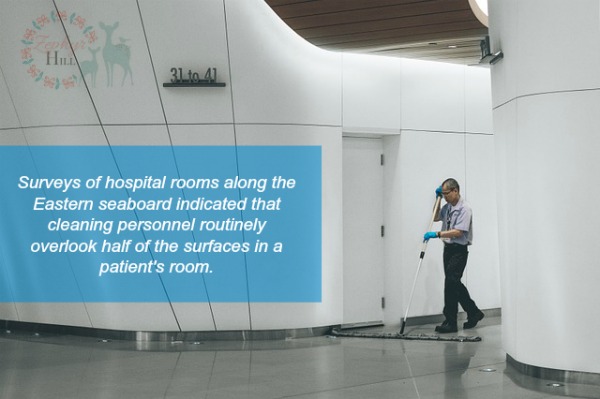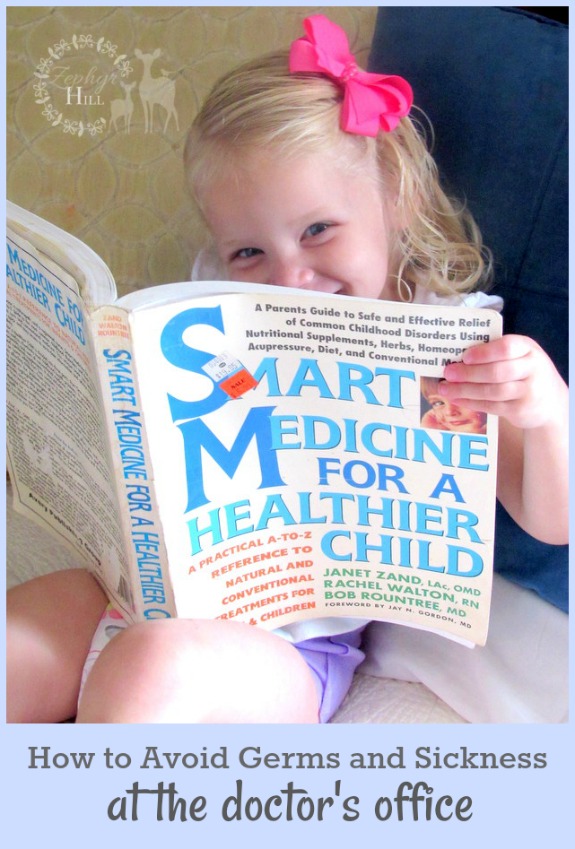Have you ever gone to the doctor for a physical or well-baby visit and ended up with someone becoming sick soon after? Or maybe your child was getting tested for strep but accidentally got exposed to norovirus. Sadly ironic, right?
We think of a doctor’s office as being a clean and sanitized place. With sick people and germs everywhere, it’s natural to assume that the facility is cleaned frequently and thoroughly. But the reality is that a lot of germs slip through the cracks. So you need to be extra vigilant at the doctor’s office.
WHY CLINICS AREN’T SO CLEAN
Cleaning products and methods used: There is no single standard which is followed from clinic to clinic, and viruses and bacteria aren’t all destroyed in the same way.
Situational error: Cleaning protocols may be compromised during rush times. Emergency situations might also result in carelessness.
Human error: Surveys of hospital rooms along the Eastern seaboard indicated that cleaning personnel routinely overlook half of the surfaces in a patient’s room. A University of Maryland study showed that 65 percent of medical professionals admitted they had not laundered their lab coat in at least a week, even though they knew it was soiled. An AORN study of over 71 operating rooms revealed that only 25% were cleaned thoroughly.

Technology: Nurses and doctors are toting laptops around now, and spend most of your office visit typing on a keyboard. This new practice has opened yet another channel for germs to spread, and it’s my personal opinion that cleaning protocols haven’t quite caught up to it yet.
It’s in the air: Many infections can be spread via airborne transmission, such as flu, chicken pox and tuberculosis. Having clean hands is pointless when a sick person coughs or sneezes nearby. Did you know that measles virus can live for two hours in the air after the infected person has exited the room? Here’s the story of one boy who infected seven other children with measles at a clinic within one day; only one actually had direct contact with him. Another child came in contact with the pathogen a full hour after the measles patient had left!
Limited oversight: The Joint Commission (which inspects and accredits hospitals) does not measure cleanliness.
What does this mean for you as a parent? It means a lot of responsibility falls on you and your children to stop the spread of germs. Here are some practical ways you can do that.
HOW TO STAY WELL:
Go alone. This may be the hardest prescription to follow, but only go to the clinic when absolutely necessary, and don’t take anyone who doesn’t need to be there. If that means getting a babysitter, it’s worth it. Or, ask a friend or responsible teenager to sit with your other children in the vehicle while you run in the clinic (alone or with the patient). Do your part to keep illness contained. That means keeping sick people at home where they belong while they are contagious instead of dragging them through public places exposing other people to pathogens.
In the old days, people took the idea of “quarantine” much more seriously, and in that way are much more progressive than moderns. If everyone followed these precautions, then children and adults who are there just for well-child and physicals would be better protected.
Some clinics have separate waiting rooms for well-child visits and physicals, but it’s costly, so this is far from being widely available.

Be informed about what’s going around. Don’t take your child in for a vaccination or well baby visit while stomach virus or strep throat is raging in your community. Postpone until things settle down. All it takes is a quick call to your local clinic or doctor’s office. They can tell you which illnesses are currently circulating.
Honor hospital policies. Pay attention to posted signs because these instructions are for everyone’s benefit. Clinics will often request that you inform staff about certain symptoms you are having, or that you wash/sanitize your hands after entering. Use designated stations for changing diapers, and if there aren’t disposable covers for seats and changing stations, inform staff right away.
Be wary in the waiting room. Don’t touch anything you don’t have to because the typical waiting room is rife with germs. No one sanitizes the books and magazines, so bring your own reading material. Watch your children closely (I know, I know) and keep little ones on your lap, if possible. Use your own pen to sign documents. Don’t set your purse or diaper bag on the floor (keep it on your lap or shoulder). Forgo the hospital vending machine and the public fountain.
You can also check and see if there is a clinic in your area that maintains separate waiting rooms for sick patients and well patients.
Keep your hands clean. The alcohol-based hand sanitizer provided by hospitals is nice, but it doesn’t kill stomach virus, E. Coli or C. Difficile. (I buy the 2-packs of Zylast on Amazon and keep one in my purse during stomach virus season!).
This Purell spray kills norovirus, E.Coli and salmonella on surfaces. These two hand sanitizers – Clorox and My Shield – are advertised to kill norovirus as well.
Some viruses and bacteria also take longer to kill than others. Your best bet is always to wash your hands thoroughly with soap and warm water, and limit what you touch afterwards. But do NOT forget that hand-washing is only one line of defense (see “wear a mask” above) and is not going to protect you from all pathogens.
Schedule early and arrive early. The earlier in the day you arrive, the less germ accumulation there is. And try not to be late, because some clinics will admit the next in line, leaving you in the waiting room that much longer. That adds to the time you’ll be exposed to sick people coming and going.
Do you have any other ideas to share for steering clear of germs and infections at the doctor’s office?



Yes! The number of hospital and doctor office acquired infections are so easily preventable with a little cleaning! Sad part is that these issues are preventable! Hospitals are all for profit and if that means saving a few dollars on the cleaning staff, then they’re willing to let people get sick.
I have witnessed this in person on several occasions at local clinics (messes that were not properly cleaned and sanitized). And it made me wonder what other things are being routinely overlooked!
You know I never really thought about most of these, thank you! It’s scary to think that hospitals and doctors offices are not as clean as we think.
This is really helpful. I didn’t know there was a difference in what the types of sanitizers could do. I’m going to keep this in mind going forward.
This is so true. It is so easy to contract an infection just by sitting in the waiting room. I think the best tip would be to arrive early and leave early. Less people, less risk.
That tip about arriving early is one I hadn’t ever thought of- good idea!
Definitely being aware of what’s going on in the community and being proactive with wearing a mask and keeping your hands clean are great suggestions. It’s everyone’s responsibility to help keep germs down as much as possible.
I know germs are all over but our doctor’s office has a sick bay. Healthy well visit kids go to another area to help prevent the spread of viruses.
I never really thought about the cleaning practices of clinics and hospitals before. I just knew that there were germs floating around considering the waiting room had sick people in it. I always have my own hand sanitizer in my purse. Going early is a good idea.
We’ve been lucky to always have newer facilities, but it comes down to the staff. I guess maybe pay them more?
This is really a great reminder for moms and for everyone. There could be a lot of germs in the clinics and hospitals. It’s always great to be ready.
Anytime we visit the doctors office I am constantly sanitizing my hands. I don’t wanna catch any germs
These are great tips and I agree with all of them. I always requesting an early appointment from my Doctor’s clinic because of these reasons and when I got home I took a bath first before touching my kids just to be sure that I did not spread them the viruses from the hospital.
These are all excellent points, especially not taking healthy kids to the dr office. I’ve had children catch things just by going with me.
I once worked in a pediatrician’s office and they scheduled all the well visits seperately from the sick ones. I thought it was quite logical.
Great policy – makes sense to me! ~Anne Marie
So important! Every time I go to the doctors I feel so gross so these tips are great